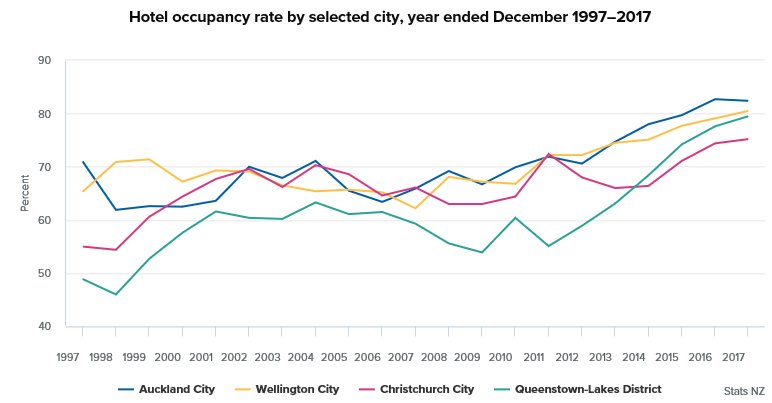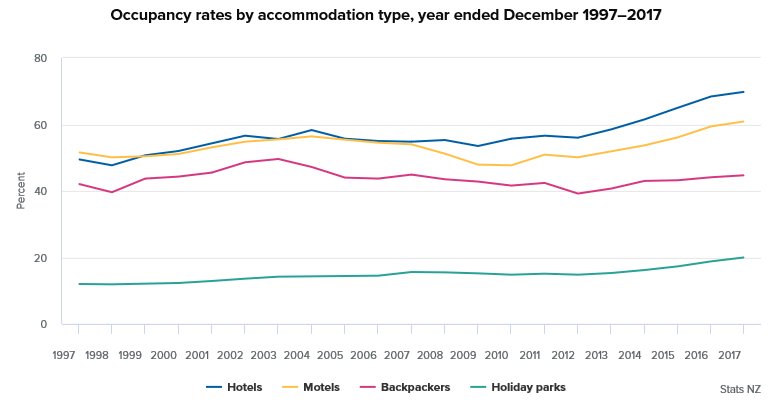Record high occupancy for hotels in 2017
New Zealand hotels are the busiest they have ever been,
with a record high occupancy rate of almost 70 percent in
the year ended December 2017, Stats NZ said
today.
Overall, the occupancy rate of New Zealand’s short-term commercial accommodation rose to a record 44.9 percent in the year ended December 2017, an increase of 1.3 percentage points from 2016.
“Occupancy rates are a measure of how full accommodation is on average across the year, and how difficult it may be to find a room,” accommodation and construction statistics manager Melissa McKenzie said. “Occupancy rates typically rise when more rooms are booked, but they can also move up if rooms are out of action, for example during renovations.”
Hotels in the main cities generally have higher occupancy rates. Of the main cities, Auckland hotels had the highest occupancy rate in 2017, though down slightly from 2016 to 82.4 percent. The decrease in Auckland’s hotel occupancy rate was caused by more rooms becoming available.
In Wellington, Christchurch, and Queenstown-Lakes, occupancy rates increased to 80.5 percent, 75.2 percent, and 79.5 respectively, all annual record highs, helped by record visitor arrivals to New Zealand during 2017.

“In 2017, high occupancy rates for hotels in our main cities coincided with more building consents issued for new hotels,” Ms McKenzie said.
See Conferences, culture, and tourism boost consents for more information about 2017 building consents.
While hotels had the highest occupancy rate of the accommodation types, occupancy rates for motels and holiday parks also reached record levels in 2017.
The occupancy rate for motels rose 1.5 percentage points to 60.9 percent. Holiday parks had the lowest occupancy rate, up 1.2 percentage points to 20.0 percent. Holiday parks typically have a lower annual occupancy rate than the other accommodation types, mainly due to their seasonal nature and the high volumes of tent sites that pull down the occupancy rate when not in use.
The rate for backpacker accommodation increased slightly, up 0.6 percentage points to 44.7 percent.

The accommodation survey
collects data for guests staying in short-term commercial
accommodation such as hotels, motels, backpackers, and
holiday parks. Hosted and private accommodation, such as bed
and breakfasts and holiday homes, are
excluded.
Ends


 John Mazenier: Gaffer Tape And Glue Delivering New Zealand’s Mission Critical Services
John Mazenier: Gaffer Tape And Glue Delivering New Zealand’s Mission Critical Services Earthquake Commission: Ivan Skinner Award Winner Inspired By Real-life Earthquake Experience
Earthquake Commission: Ivan Skinner Award Winner Inspired By Real-life Earthquake Experience Reserve Bank: Consultation Opens On A Digital Currency For New Zealand
Reserve Bank: Consultation Opens On A Digital Currency For New Zealand NIWA: Ship Anchors May Cause Extensive And Long-lasting Damage To The Seafloor, According To New Research
NIWA: Ship Anchors May Cause Extensive And Long-lasting Damage To The Seafloor, According To New Research New Zealand Customs Service: A Step Forward For Simpler Trade Between New Zealand And Singapore
New Zealand Customs Service: A Step Forward For Simpler Trade Between New Zealand And Singapore Horizon Research: 68% Say Make Banks Offer Fraud Protection
Horizon Research: 68% Say Make Banks Offer Fraud Protection



